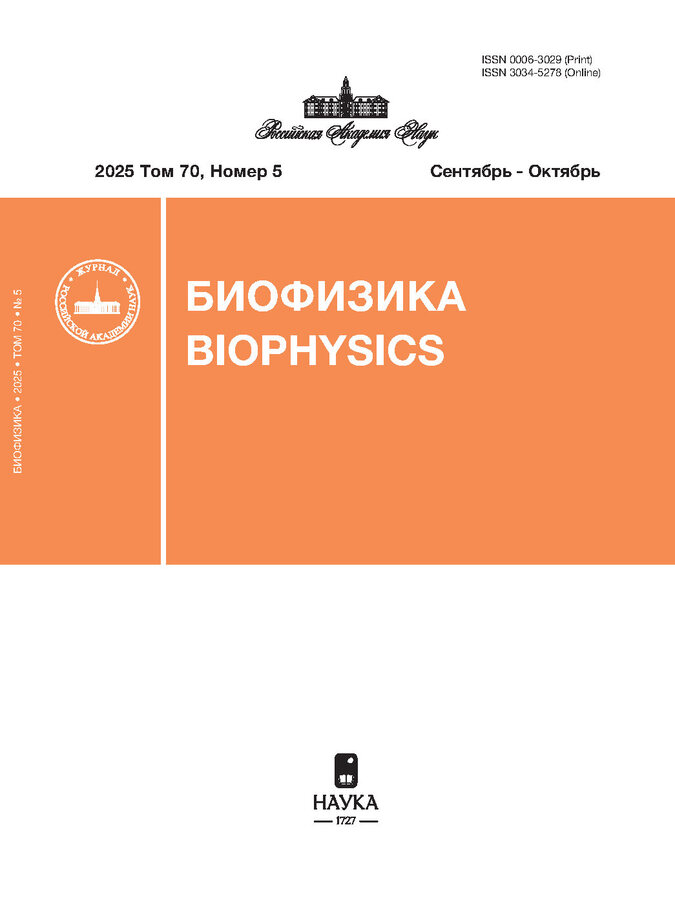Control of the Activity of Mobile Elements in Cancer Cells as a Strategy for Anticancer Therapy
- Authors: Pavlov S.R1, Gursky V.V1,2, Samsonova M.G1, Kanapin A.A1, Samsonova A.A1
-
Affiliations:
- Peter the Great St. Petersburg Polytechnic University
- Ioffe Physical-Technical Institute
- Issue: Vol 69, No 6 (2024)
- Pages: 1231-1234
- Section: Cell biophysics
- URL: https://gynecology.orscience.ru/0006-3029/article/view/676149
- DOI: https://doi.org/10.31857/S0006302924050102
- EDN: https://elibrary.ru/NLAKHR
- ID: 676149
Cite item
Abstract
About the authors
S. R Pavlov
Peter the Great St. Petersburg Polytechnic UniversitySaint Petersburg, Russia
V. V Gursky
Peter the Great St. Petersburg Polytechnic University; Ioffe Physical-Technical Institute
Email: gursky@math.ioffe.ru
Saint Petersburg, Russia
M. G Samsonova
Peter the Great St. Petersburg Polytechnic UniversitySaint Petersburg, Russia
A. A Kanapin
Peter the Great St. Petersburg Polytechnic UniversitySaint Petersburg, Russia
A. A Samsonova
Peter the Great St. Petersburg Polytechnic UniversitySaint Petersburg, Russia
References
- Moreira D. A., de Lanna C. A., da Cruz J. G. V., and Boroni M. To build or to break: the dual impact of interspersed transposable elements in cancer. In Human Genome Structure, Function and Clinical Considerations, Ed. by L. A. Haddad (N.-Y., Springer, Cham., 2021), pp. 245-273. doi: 10.1007/978-3-030-73151-9_8
- Demidov G., Park J., Armeanu-Ebinger S., Roggia C., Faust U., Cordts I., Blandfort M., Haack T. B., Schroeder C., and Ossowski S. Detection of mobile elements insertions for routine clinical diagnostics in targeted sequencing data. Mol. Genet. Genom. Med., 9 (12), e1807 (2021). doi: 10.1002/mgg3.1807
- Steely C. J., Russell K. L., Feusier J. E., Qiao Y., Tavtigian S. V., Marth G., and Jorde L.B. Mobile element insertions and associated structural variants in longitudinal breast cancer samples. Sci. Rep., 11 (1), 13020 (2021). doi: 10.1038/s41598-021-92444-0
- Solovyov A., Behr J. M., Hoyos D., Banks E., Drong A. W., Zhong J. Z., Garcia-Rivera E., McKerrow W., Chu C., Zaller D. M., Fromer M., and Greenbaum B. D. Mechanism-guided quantification of LINE-1 reveals p53 regulation of both retrotransposition and transcription. BioRxiv, 2023.05.11.539471 (2023). doi: 10.1101/2023.05.11.539471
- Pradhan R. K. and Ramakrishna W. Transposons: unexpected players in cancer. Gene, 808, 145975 (2022). doi: 10.1016/j.gene.2021.145975
- Burns K.H. Transposable elements in cancer. Nat. Rev. Cancer, 17 (7), 415-424 (2017). doi: 10.1038/nrc.2017.35
- Kassiotis G. and Stoye J. P. Immune responses to endogenous retroelements: taking the bad with the good. Nat. Rev. Immunol., 16 (4), 207-219 (2016). doi: 10.1038/nri.2016.27
- Ishak C. A. and De Carvalho D. D. Reactivation of endogenous retroelements in cancer development and therapy. Annu. Rev. Cancer Biol., 4 (1), 159-176 (2020). doi: 10.1146/annurev-cancerbio-030419-033525
- Leonova K. I., Brodsky L., Lipchick B., Pal M., Novototskaya L., Chenchik A. A., Sen G. C., Komarova E. A., and Gudkov A. V. p53 cooperates with DNA methylation and a suicidal interferon response to maintain epigenetic silencing of repeats and noncoding RNAs. Proc. Natl. Acad. Sci. USA, 110 (1), E89-98 (2013). doi: 10.1073/pnas.1216922110
- Chiappinelli K. B., Strissel P. L., Desrichard A., Li H., Henke C., Akman B., Hein A., Rote N. S., Cope L. M., Snyder A., Makarov V., Budhu S., Slamon D. J., Wolchok J. D., Pardoll D. M., Beckmann M. W., Zahnow C. A., Merghoub T., Chan T. A., Baylin S. B., and Strick R. Inhibiting DNA methylation causes an interferon response in cancer via dsRNA including endogenous retroviruses. Cell, 162 (5), 974-986 (2015). doi: 10.1016/j.cell.2015.07.011
- Roulois D., Loo Yau H., Singhania R., Wang Y., Danesh A., Shen S. Y., Han H., Liang G., Jones P. A., Pugh T. J., O’Brien C., and De Carvalho D. D. DNA-demethylating agents target colorectal cancer cells by inducing viral mimicry by endogenous transcripts. Cell, 162 (5), 961-973 (2015). doi: 10.1016/j.cell.2015.07.056
- Ishak C. A., Classon M., and De Carvalho D. D. Deregulation of retroelements as an emerging therapeutic opportunity in cancer. Trends Cancer, 4 (8), 583-597 (2018). doi: 10.1016/j.trecan.2018.05.008
- DeBerardinis R. J. and Chandel N. S. Fundamentals of cancer metabolism. Sci. Adv., 2 (5), e1600200 (2016). doi: 10.1126/sciadv.1600200
- Vander Heiden M. G. and DeBerardinis R. J. Understanding the intersections between metabolism and cancer biology. Cell, 168 (4), 657-669 (2017). doi: 10.1016/j.cell.2016.12.039
- Fresquet V., Garcia-Barchino M. J., Larrayoz M., Celay J., Vicente C., Fernandez-Galilea M., Larrayoz M. J., Calasanz M. J., Panizo C., Junza A., Han J., Prior C., Fortes P., Pio R., Oyarzabal J., Martinez-Baztan A., Paiva B., Moreno-Aliaga M. J., Odero M. D., Agirre X., Yanes O., Prosper F., and Martinez-Climent J. A. Endogenous retroelement activation by epigenetic therapy reverses the warburg effect and elicits mitochondrial-mediated cancer cell death. Cancer Discov., 11 (5), 1268-1285 (2021). doi: 10.1158/2159-8290.CD-20-1065
- Takeshima H., Yoda Y., Wakabayashi M., Hattori N., Yamashita S., and Ushijima T. Low-dose DNA demethylating therapy induces reprogramming of diverse cancer-related pathways at the single-cell level. Clin. Epigenetics, 12 (1), 142 (2020). doi: 10.1186/s13148-020-00937-y
- Wagner A. Energy constraints on the evolution of gene expression. Mol. Biol. Evol., 22 (6), 1365-1374 (2005). doi: 10.1093/molbev/msi126
- Lane N. and Martin W. The energetics of genome complexity. Nature, 467 (7318), 929-934 (2010). doi: 10.1038/nature09486
- Lynch M. and Marinov G. K. The bioenergetic costs of a gene. Proc. Natl. Acad. Sci. USA, 112 (51), 1569015695 (2015). doi: 10.1073/pnas.1514974112
- Raveh A., Margaliot M., Sontag E. D., and Tuller T. A model for competition for ribosomes in the cell. J. R. Soc. Interface, 13 (116), 20151062 (2016). doi: 10.1098/rsif.2015.1062
- Rogalla P. S., Rudge T. J., and Ciandrini L. An equilibrium model for ribosome competition. Phys. Biol., 17 (1), 015002 (2019). doi: 10.1088/1478-3975/ab4fbc
- Vander Heiden M. G., Cantley L. C., and Thompson C. B. Understanding the Warburg effect: the metabolic requirements of cell proliferation. Science, 324 (5930), 1029-1033 (2009). doi: 10.1126/science.1160809
- Hanahan D. and Weinberg R. A. Hallmarks of cancer: the next generation. Cell, 144 (5), 646-674 (2011). doi: 10.1016/j.cell.2011.02.013
- Kasperski A. and Kasperska R. Bioenergetics of life, disease and death phenomena. Theor. Biosci., 137 (2), 155-168 (2018). doi: 10.1007/s12064-018-0266-5
- Eguchi Y., Shimizu S., and Tsujimoto Y. Intracellular ATP levels determine cell death fate by apoptosis or necrosis. Cancer Res., 57 (10), 1835-1840 (1997).
- Lieberthal W., Menza S. A., and Levine J. S. Graded ATP depletion can cause necrosis or apoptosis of cultured mouse proximal tubular cells. Am. J. Physiol. Renal Physiol., 274 (2), F315-F327 (1998). doi: 10.1152/ajprenal.1998.274.2.f315
- Skulachev V. P. Bioenergetic aspects of apoptosis, necrosis and mitoptosis. Apoptosis, 11 (4), 473-485 (2006). doi: 10.1007/s10495-006-5881-9
- Weiße A. Y., Oyarzún D. A., Danos V., and Swain P. S. Mechanistic links between cellular trade-offs, gene expression, and growth. Proc. Natl. Acad. Sci. USA, 112 (9), E1038-E1047 (2015). doi: 10.1073/pnas.1416533112
- Thomas P., Terradot G., Danos V., and Weiße A. Y. Sources, propagation and consequences of stochasticity in cellular growth. Nat. Commun., 9 (1), 4528 (2018). doi: 10.1038/s41467-018-06912-9
Supplementary files








